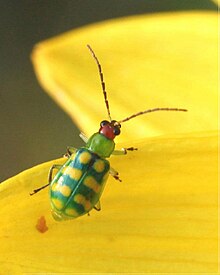
The Colorado potato beetle, also known as the Colorado beetle, the ten-striped spearman, the ten-lined potato beetle, or the potato bug, is a major pest of potato crops. It is about 10 mm long, with a bright yellow/orange body and five bold brown stripes along the length of each of its elytra. Native to the Rocky Mountains, it spread rapidly in potato crops across America and then Europe from 1859 onwards.
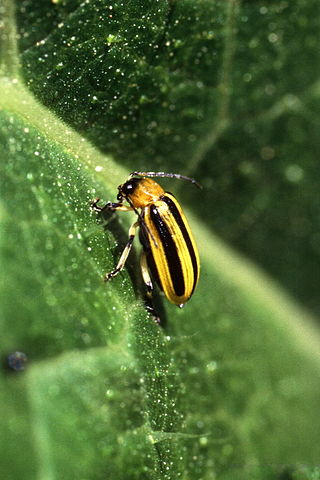
Acalymma vittatum, the striped cucumber beetle, is a beetle of the family Chrysomelidae and a serious pest of cucurbit crops in both larval and adult stages. It is distributed from eastern North America to the Rocky Mountains. It is replaced in the west by Acalymma trivittatum, a duller species often with greyish or pale white elytra rather than yellow.

The cereal leaf beetle is a significant crop pest, described by Carl Linnaeus in 1758.

Diabrotica undecimpunctata, the spotted cucumber beetle or southern corn rootworm, is a species of cucumber beetle that is native to North America. The species can be a major agricultural pest insect in North America. Spotted cucumber beetles cause damage to crops in the larval and adult stages of their life cycle. Larvae feed on the roots of the emerging plants, which causes the most damage since the young plants are more vulnerable. In the adult stage the beetles cause damage by eating the flowers, leaves, stems, and fruits of the plant The beetles can also spread diseases such as bacterial wilt and mosaic virus.
Belonolaimus longicaudatus is a common parasite of grasses and other plant crops and products. It is the most destructive nematode pest of turf grass, and it also attacks a wide range of fruit, vegetable, and fiber crops such as citrus, cotton, ornamentals, and forage. The sting nematode is a migratory ectoparasite of roots. It is well established in many golf courses and presents a problem in turf management. The sting nematode is only present in very sandy soils. It cannot reproduce in heavier or clay soils.

Rotylenchulus reniformis, the reniform nematode, is a species of parasitic nematode of plants with a worldwide distribution in the tropical and subtropical regions.
Xiphinema americanum, the American dagger nematode, is a species of plant pathogenic nematodes. It is one of many species that belongs to the genus Xiphinema. It was first described by N. A. Cobb in 1913, who found it on both sides of the United States on the roots of grass, corn, and citrus trees. Not only is Xiphinema americanum known to vector plant viruses, but also X. americanum has been referred to as "the most destructive plant parasitic nematode in America", and one of the four major nematode pests in the Southeastern United States.

Myzus persicae, known as the green peach aphid, greenfly, or the peach-potato aphid, is a small green aphid belonging to the order Hemiptera. It is the most significant aphid pest of peach trees, causing decreased growth, shrivelling of the leaves and the death of various tissues. It also acts as a vector for the transport of plant viruses such as cucumber mosaic virus (CMV), potato virus Y (PVY) and tobacco etch virus (TEV). Potato virus Y and potato leafroll virus can be passed to members of the nightshade/potato family (Solanaceae), and various mosaic viruses to many other food crops.

Callosobruchus maculatus is a species of beetles known commonly as the cowpea weevil or cowpea seed beetle. It is a member of the leaf beetle family, Chrysomelidae, and not a true weevil. This common pest of stored legumes has a cosmopolitan distribution, occurring on every continent except Antarctica. The beetle most likely originated in West Africa and moved around the globe with the trade of legumes and other crops. As only a small number of individuals were likely present in legumes carried by people to distant places, the populations that have invaded various parts of the globe have likely gone through multiple bottlenecks. Despite these bottlenecks and the subsequent rounds of inbreeding, these populations persist. This ability to withstand a high degree of inbreeding has likely contributed to this species’ prevalence as a pest.
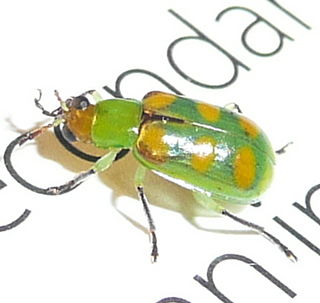
Diabrotica speciosa, also known as the cucurbit beetle and in Spanish as vaquita de San Antonio is an insect pest native to South America. Its larvae feed on the roots of crops. The cucurbit beetle is also known to transmit several viruses such as comoviruses and different mosaic viruses. This is native to South America and is now distributed in Central America and other global areas.

Coleomegilla maculata, commonly known as the spotted lady beetle, pink spotted lady beetle or twelve-spotted lady beetle, is a large coccinellid beetle native to North America. The adults and larvae feed primarily on aphids and the species has been used as a biological control agent. Based on name connotation and to avoid confusion with other species also called "spotted ladybeetle", spotted pink ladybeetle is probably the most appropriate common name for this species.
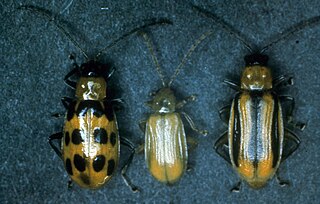
Cucumber beetle is a common name given to members of two genera of beetles, Diabrotica and Acalymma, both in the family Chrysomelidae. The adults can be found on cucurbits such as cucumbers and a variety of other plants. Many are notorious pests of agricultural crops. The larvae of several cucumber beetles are known as corn rootworms.

Cerotoma trifurcata is a species of beetle in the Chrysomelidae family that can be found in the Eastern and West United States.

Gratiana boliviana is a species of beetle in the leaf beetle family, Chrysomelidae. Its common name is tropical soda apple leaf beetle. It is native to South America, where its distribution includes Argentina, Brazil, and Paraguay. It specializes on tropical soda apple, an invasive plant species. It has been released as an agent of biological pest control against the weedy plant in Florida and other parts of the United States.

Bruchus is a genus of beetles in the leaf beetle family, Chrysomelidae. They are distributed mainly in the Palearctic, especially in Europe. Several occur in other parts of the world, such as North America, Africa, and Australia, as introduced species. Several species are notorious agricultural pests.
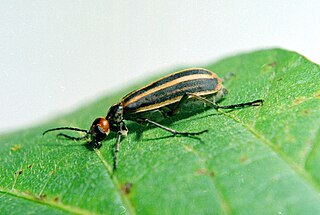
Epicauta vittata is a species of beetle in the family Meloidae, the blister beetles. It is native to eastern North America, including eastern Canada and the eastern United States. It is known commonly as the striped blister beetle and the old-fashioned potato beetle. It is known as an agricultural pest.

Aphis craccivora, variously known as the cowpea aphid, groundnut aphid or black legume aphid, is a true bug in the family Aphididae. Originally of probable Palearctic origin, it is now an invasive species of cosmopolitan distribution.

Callosobruchus chinensis is a common species of beetle found in the bean weevil subfamily, and is known to be a pest to many stored legumes. Although it is commonly known as the adzuki bean weevil it is in fact not a true weevil, belonging instead to the leaf beetle family, Chrysomelidae. Other common names include the pulse beetle, Chinese bruchid and cowpea bruchid. This species has a very similar lifestyle and habitat to Callosobruchus maculatus and their identities are often mistaken for each other. This beetle is a common pest targeting many different species of stored legumes and it is distributed across the tropical and subtropical regions of the world. C. chinensis is one of the most damaging crop pests to the stored legume industry due to their generalized legume diets and wide distribution.
Acyrthosiphon kondoi, the blue alfalfa aphid or bluegreen aphid, is an aphid in the superfamily Aphidoidea in the order Hemiptera. It is a true bug and sucks sap from leguminous plants, particularly alfalfa.
Holotrichia serrata, commonly known as the sugarcane white grub, or cockchafer grub, is a species of dung beetle found in India, Bangladesh, and Sri Lanka.
